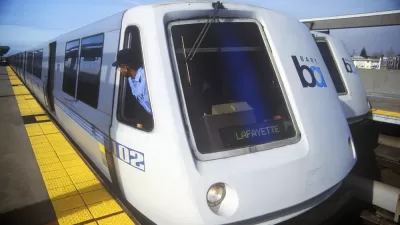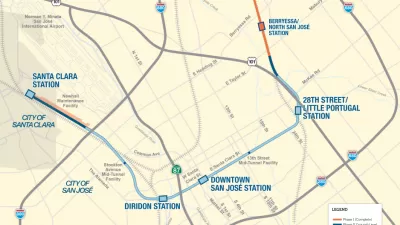What seemed for decades like an impossible dream is becoming more and more of a reality: BART service to San Jose and the Silicon Valley.
In an announcement for the Santa Clara Valley Transportation Authority, Brandi Childress writes of a critical development in the extension of bay Area Rapid Transit (BART) into the Silicon Valley:
The Federal Transit Administration (FTA) has given VTA the green light to enter the six-mile BART Silicon Valley Phase II Extension into the Project Development phase of the Federal New Starts funding program. This milestone signifies that VTA has “pre-award authority” to incur costs to advance engineering and design activities to support the environmental review process.
The news was big (and good) enough to draw soundbites out of U.S. Rep. Mike Honda (D-Silicon Valley) and VTA Board Chair and Santa Clara County Supervisor Cindy Chavez. Childress also provides details about Phase II, as currently conceived: "Phase II of VTA’s BART Silicon Valley Project consists of four stations and a 5-mile tunnel through downtown San Jose, completing the 16-mile extension and vital transit solution to highly congested and constrained I-880 and I-680 corridors."
As for Phase I, otherwise known as the BART Silicon Valley Berryessa Extension, "[j]ust over eighty percent of the construction contract to build the line, track, stations and systems is complete. By spring next year, BART (operator) is expected to begin to test trains on the newly built 10-mile segment."
For more information on the addition of regional transit to the Silicon Valley, an article by Timothy Schmidt and Bernice Alaniz, published by Metro magazine in January 2016, details the history of the project and looks forward to its future.
FULL STORY: Phase II of VTA’s BART Silicon Valley Project Gets FTA Green Light

Alabama: Trump Terminates Settlements for Black Communities Harmed By Raw Sewage
Trump deemed the landmark civil rights agreement “illegal DEI and environmental justice policy.”

Planetizen Federal Action Tracker
A weekly monitor of how Trump’s orders and actions are impacting planners and planning in America.

Why Should We Subsidize Public Transportation?
Many public transit agencies face financial stress due to rising costs, declining fare revenue, and declining subsidies. Transit advocates must provide a strong business case for increasing public transit funding.

Understanding Road Diets
An explainer from Momentum highlights the advantages of reducing vehicle lanes in favor of more bike, transit, and pedestrian infrastructure.

New California Law Regulates Warehouse Pollution
A new law tightens building and emissions regulations for large distribution warehouses to mitigate air pollution and traffic in surrounding communities.

Phoenix Announces Opening Date for Light Rail Extension
The South Central extension will connect South Phoenix to downtown and other major hubs starting on June 7.
Urban Design for Planners 1: Software Tools
This six-course series explores essential urban design concepts using open source software and equips planners with the tools they need to participate fully in the urban design process.
Planning for Universal Design
Learn the tools for implementing Universal Design in planning regulations.
Caltrans
Smith Gee Studio
Institute for Housing and Urban Development Studies (IHS)
City of Grandview
Harvard GSD Executive Education
Toledo-Lucas County Plan Commissions
Salt Lake City
NYU Wagner Graduate School of Public Service





























